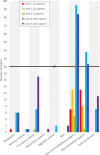Clinical efficacy and effectiveness of 3D printing: a systematic review
- PMID: 29273650
- PMCID: PMC5778284
- DOI: 10.1136/bmjopen-2017-016891
Clinical efficacy and effectiveness of 3D printing: a systematic review
Abstract
Objective: To evaluate the clinical efficacy and effectiveness of using 3D printing to develop medical devices across all medical fields.
Design: Systematic review compliant with Preferred Reporting Items for Systematic Reviews and Meta-Analyses.
Data sources: PubMed, Web of Science, OVID, IEEE Xplore and Google Scholar.
Methods: A double-blinded review method was used to select all abstracts up to January 2017 that reported on clinical trials of a three-dimensional (3D)-printed medical device. The studies were ranked according to their level of evidence, divided into medical fields based on the International Classification of Diseases chapter divisions and categorised into whether they were used for preoperative planning, aiding surgery or therapy. The Downs and Black Quality Index critical appraisal tool was used to assess the quality of reporting, external validity, risk of bias, risk of confounding and power of each study.
Results: Of the 3084 abstracts screened, 350 studies met the inclusion criteria. Oral and maxillofacial surgery contained 58.3% of studies, and 23.7% covered the musculoskeletal system. Only 21 studies were randomised controlled trials (RCTs), and all fitted within these two fields. The majority of RCTs were 3D-printed anatomical models for preoperative planning and guides for aiding surgery. The main benefits of these devices were decreased surgical operation times and increased surgical accuracy.
Conclusions: All medical fields that assessed 3D-printed devices concluded that they were clinically effective. The fields that most rigorously assessed 3D-printed devices were oral and maxillofacial surgery and the musculoskeletal system, both of which concluded that the 3D-printed devices outperformed their conventional comparators. However, the efficacy and effectiveness of 3D-printed devices remain undetermined for the majority of medical fields. 3D-printed devices can play an important role in healthcare, but more rigorous and long-term assessments are needed to determine if 3D-printed devices are clinically relevant before they become part of standard clinical practice.
Keywords: additive manufacturing; fabrication; health care evaluation mechanisms; medical devices; personalised healthcare; printing, three-dimensional.
© Article author(s) (or their employer(s) unless otherwise stated in the text of the article) 2017. All rights reserved. No commercial use is permitted unless otherwise expressly granted.
Conflict of interest statement
Competing interests: None declared.
Figures
Similar articles
-
A rapid and systematic review of the clinical effectiveness and cost-effectiveness of topotecan for ovarian cancer.Health Technol Assess. 2001;5(28):1-110. doi: 10.3310/hta5280. Health Technol Assess. 2001. PMID: 11701100
-
Drugs for preventing postoperative nausea and vomiting in adults after general anaesthesia: a network meta-analysis.Cochrane Database Syst Rev. 2020 Oct 19;10(10):CD012859. doi: 10.1002/14651858.CD012859.pub2. Cochrane Database Syst Rev. 2020. PMID: 33075160 Free PMC article.
-
Intravenous magnesium sulphate and sotalol for prevention of atrial fibrillation after coronary artery bypass surgery: a systematic review and economic evaluation.Health Technol Assess. 2008 Jun;12(28):iii-iv, ix-95. doi: 10.3310/hta12280. Health Technol Assess. 2008. PMID: 18547499
-
Systemic pharmacological treatments for chronic plaque psoriasis: a network meta-analysis.Cochrane Database Syst Rev. 2021 Apr 19;4(4):CD011535. doi: 10.1002/14651858.CD011535.pub4. Cochrane Database Syst Rev. 2021. Update in: Cochrane Database Syst Rev. 2022 May 23;5:CD011535. doi: 10.1002/14651858.CD011535.pub5. PMID: 33871055 Free PMC article. Updated.
-
Home treatment for mental health problems: a systematic review.Health Technol Assess. 2001;5(15):1-139. doi: 10.3310/hta5150. Health Technol Assess. 2001. PMID: 11532236
Cited by
-
The current progress and critical analysis of three-dimensional scanning and three-dimensional printing applications in breast surgery.BJS Open. 2021 May 7;5(3):zrab025. doi: 10.1093/bjsopen/zrab025. BJS Open. 2021. PMID: 33963367 Free PMC article. Review.
-
Implementation of an In-House 3D Manufacturing Unit in a Public Hospital's Radiology Department.Healthcare (Basel). 2022 Sep 16;10(9):1791. doi: 10.3390/healthcare10091791. Healthcare (Basel). 2022. PMID: 36141403 Free PMC article.
-
Advanced Pharmaceutical Applications of Hot-Melt Extrusion Coupled with Fused Deposition Modelling (FDM) 3D Printing for Personalised Drug Delivery.Pharmaceutics. 2018 Oct 24;10(4):203. doi: 10.3390/pharmaceutics10040203. Pharmaceutics. 2018. PMID: 30356002 Free PMC article. Review.
-
Commentary: Development of a Computer-Aided Design and Finite Element Analysis Combined Method for Affordable Spine Surgical Navigation With 3D-Printed Customized Template.Front Surg. 2021 Sep 23;8:743290. doi: 10.3389/fsurg.2021.743290. eCollection 2021. Front Surg. 2021. PMID: 34631786 Free PMC article. No abstract available.
-
Leveraging Digital Workflows to Transition the Orthotics and Prosthetics Profession Toward a Client-Centric and Values-Based Care Model.Can Prosthet Orthot J. 2023 Dec 22;6(2):42221. doi: 10.33137/cpoj.v6i2.42221. eCollection 2023. Can Prosthet Orthot J. 2023. PMID: 38873133 Free PMC article.
References
-
- Royal Academy of Engineering. Additive manufacturing: opportunities and constraints [Internet]. London: Royal Academy of Engineering, 2013. http://www.raeng.org.uk/publications/reports/additive-manufacturing
Publication types
MeSH terms
Grants and funding
LinkOut - more resources
Full Text Sources
Other Literature Sources
Molecular Biology Databases
Miscellaneous


